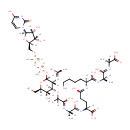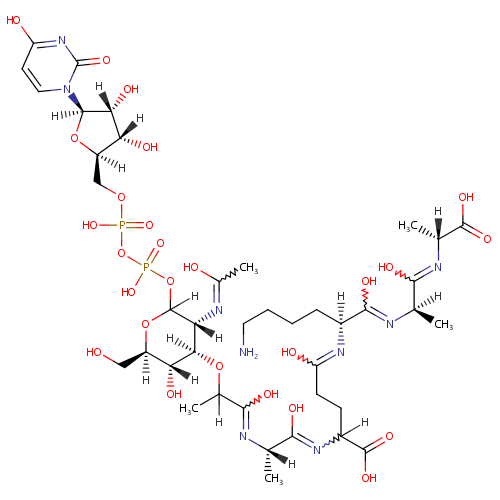|
Record Information |
|---|
| Version |
1.0 |
|---|
| Update Date |
1/22/2018 11:54:54 AM |
|---|
|
Metabolite ID | PAMDB001051 |
|---|
|
Identification |
|---|
| Name: |
UDP-N-Acetylmuramoyl-L-alanyl-D-glutamyl-L-lysyl-D-alanyl-D-alanine |
|---|
| Description: | UDP-N-acetylmuramoyl-L-alanyl-D-glutamyl-L-lysyl-D-alanyl-D-alanine is a member of the chemical class known as Peptides. These are compounds containing an amide derived from two or more amino carboxylic acid molecules (the same or different) by formation of a covalent bond from the carbonyl carbon of one to the nitrogen atom of another. UDP-MurNAc-pentapeptide is a peptidoglycan precursor. It is a key component of peptidoglycan synthesis. The peptidoglycan synthesis pathway starts at the cytoplasm, where in six steps the peptidoglycan precursor a UDP-N-acetylmuramoyl-pentapeptide is synthesized. This precursor is then attached to the memberane acceptor all-trans-undecaprenyl phosphate, generating a N-acetylmuramoyl-pentapeptide-diphosphoundecaprenol, also known as lipid I. Another transferase then adds UDP-N-acetyl-alpha-D-glucosamine, yielding the complete monomeric unit a lipid , also known as lipid . This final lipid intermediate is transferred through the membrane. The peptidoglycan monomers are then polymerized on the outside surface by glycosyltransferases, which form the linear glycan chains, and transpeptidases, which catalyze the formation of peptide crosslinks. UDP-MurNAc-pentapeptide is a feedback inhibitor of UDP-MurNAc-peptide synthesis. (PMID 357424) |
|---|
|
Structure |
|
|---|
| Synonyms: | - UDP-Mur2Ac(oyl-L-Ala-g-D-Glu-L-Lys-D-Ala-D-Ala)
- UDP-MurNAc-pentapeptide
- UDP-N-Acetylmuramoyl-L-alanyl-D-glutamyl-L-lysyl-D-alanyl-D-alanine
- UDP-N-Acetylmuramoyl-L-alanyl-g-D-glutamyl-L-lysyl-D-alanyl-D-alanine
- UDP-N-Acetylmuramoyl-L-alanyl-gamma-D-glutamyl-L-lysyl-D-alanyl-D-alanine
- UDP-N-Acetylmuramoyl-L-alanyl-γ-D-glutamyl-L-lysyl-D-alanyl-D-alanine
- Udpmurac(oyl-L-ala-D-g-glu-L-lys-D-ala-D-ala)
- Udpmurac(oyl-L-ala-D-gamma-glu-L-LYS-D-ala-D-ala)
- Udpmurac(oyl-L-ala-D-γ-glu-L-lys-D-ala-D-ala)
|
|---|
|
Chemical Formula: |
C40H65N9O26P2 |
|---|
| Average Molecular Weight: |
1149.9363 |
|---|
| Monoisotopic Molecular
Weight: |
1149.351596321 |
|---|
| InChI Key: |
PFMVORMCVGOQKR-FQSOPKRZSA-N |
|---|
| InChI: | InChI=1S/C40H65N9O26P2/c1-16(32(57)44-18(3)37(61)62)43-35(60)21(8-6-7-12-41)46-25(52)10-9-22(38(63)64)47-33(58)17(2)42-34(59)19(4)71-31-27(45-20(5)51)39(73-23(14-50)29(31)55)74-77(68,69)75-76(66,67)70-15-24-28(54)30(56)36(72-24)49-13-11-26(53)48-40(49)65/h11,13,16-19,21-24,27-31,36,39,50,54-56H,6-10,12,14-15,41H2,1-5H3,(H,42,59)(H,43,60)(H,44,57)(H,45,51)(H,46,52)(H,47,58)(H,61,62)(H,63,64)(H,66,67)(H,68,69)(H,48,53,65)/t16-,17+,18-,19?,21+,22?,23-,24-,27-,28-,29-,30-,31-,36-,39?/m1/s1 |
|---|
| CAS
number: |
Not Available |
|---|
| IUPAC Name: | 4-{[(1S)-5-amino-1-{[(1R)-1-{[(1R)-1-carboxyethyl]-C-hydroxycarbonimidoyl}ethyl]-C-hydroxycarbonimidoyl}pentyl]-C-hydroxycarbonimidoyl}-2-{[(2S)-2-[(2-{[(3R,4R,5S,6R)-2-({[({[(2R,3S,4R,5R)-3,4-dihydroxy-5-(4-hydroxy-2-oxo-1,2-dihydropyrimidin-1-yl)oxolan-2-yl]methoxy}(hydroxy)phosphoryl)oxy](hydroxy)phosphoryl}oxy)-5-hydroxy-3-[(1-hydroxyethylidene)amino]-6-(hydroxymethyl)oxan-4-yl]oxy}-1-hydroxypropylidene)amino]-1-hydroxypropylidene]amino}butanoic acid |
|---|
|
Traditional IUPAC Name: |
4-{[(1S)-5-amino-1-{[(1R)-1-{[(1R)-1-carboxyethyl]-C-hydroxycarbonimidoyl}ethyl]-C-hydroxycarbonimidoyl}pentyl]-C-hydroxycarbonimidoyl}-2-{[(2S)-2-[(2-{[(3R,4R,5S,6R)-2-[({[(2R,3S,4R,5R)-3,4-dihydroxy-5-(4-hydroxy-2-oxopyrimidin-1-yl)oxolan-2-yl]methoxy(hydroxy)phosphoryl}oxy(hydroxy)phosphoryl)oxy]-5-hydroxy-3-[(1-hydroxyethylidene)amino]-6-(hydroxymethyl)oxan-4-yl]oxy}-1-hydroxypropylidene)amino]-1-hydroxypropylidene]amino}butanoic acid |
|---|
| SMILES: | [H]C(C)(O[C@@]1([H])[C@]([H])(O)[C@@]([H])(CO)OC([H])(OP(O)(=O)OP(O)(=O)OC[C@@]2([H])O[C@@]([H])(N3C=CC(O)=NC3=O)[C@]([H])(O)[C@]2([H])O)[C@]1([H])N=C(C)O)C(O)=N[C@@]([H])(C)C(O)=NC([H])(CCC(O)=N[C@@]([H])(CCCCN)C(O)=N[C@]([H])(C)C(O)=N[C@]([H])(C)C(O)=O)C(O)=O |
|---|
|
Chemical Taxonomy |
|---|
|
Taxonomy Description | This compound belongs to the class of organic compounds known as pyrimidine nucleotide sugars. These are pyrimidine nucleotides bound to a saccharide derivative through the terminal phosphate group. |
|---|
|
Kingdom |
Organic compounds |
|---|
| Super Class | Nucleosides, nucleotides, and analogues |
|---|
|
Class |
Pyrimidine nucleotides |
|---|
| Sub Class | Pyrimidine nucleotide sugars |
|---|
|
Direct Parent |
Pyrimidine nucleotide sugars |
|---|
| Alternative Parents |
|
|---|
| Substituents |
- Pyrimidine nucleotide sugar
- Pyrimidine ribonucleoside diphosphate
- Alpha peptide
- N-acyl-alpha-hexosamine
- N-acyl-aliphatic-alpha amino acid
- N-acyl-alpha amino acid or derivatives
- N-acyl-alpha-amino acid
- Glucosamine
- Amino sugar
- N-glycosyl compound
- Glycosyl compound
- Organic pyrophosphate
- Monosaccharide phosphate
- Alpha-amino acid or derivatives
- Hydroxypyrimidine
- Monoalkyl phosphate
- Amino saccharide
- Pyrimidone
- Alkyl phosphate
- Pyrimidine
- Phosphoric acid ester
- Oxane
- Organic phosphoric acid derivative
- Organic phosphate
- Monosaccharide
- Hydropyrimidine
- Dicarboxylic acid or derivatives
- Heteroaromatic compound
- Oxolane
- Secondary alcohol
- 1,2-diol
- Oxacycle
- Azacycle
- Organoheterocyclic compound
- Organic 1,3-dipolar compound
- Propargyl-type 1,3-dipolar organic compound
- Ether
- Dialkyl ether
- Carboxylic acid
- Carboxylic acid derivative
- Carboximidic acid derivative
- Carboximidic acid
- Hydrocarbon derivative
- Primary amine
- Primary alcohol
- Organooxygen compound
- Organonitrogen compound
- Primary aliphatic amine
- Carbonyl group
- Amine
- Alcohol
- Aromatic heteromonocyclic compound
|
|---|
| Molecular Framework |
Aromatic heteromonocyclic compounds |
|---|
| External Descriptors |
Not Available |
|---|
|
Physical Properties |
|---|
| State: |
Not Available |
|---|
| Charge: | -3 |
|---|
|
Melting point: |
Not Available |
|---|
| Experimental Properties: |
|
|---|
| Predicted Properties |
|
|---|
|
Biological Properties |
|---|
| Cellular Locations: |
Cytoplasm |
|---|
| Reactions: | |
|---|
|
Pathways: |
|
|---|
|
Spectra |
|---|
| Spectra: |
|
|---|
|
References |
|---|
| References: |
- Ishiguro, E. E., Ramey, W. D. (1978). "Involvement of the relA gene product and feedback inhibition in the regulation of DUP-N-acetylmuramyl-peptide synthesis in Escherichia coli." J Bacteriol 135:766-774. Pubmed: 357424
- Kanehisa, M., Goto, S., Sato, Y., Furumichi, M., Tanabe, M. (2012). "KEGG for integration and interpretation of large-scale molecular data sets." Nucleic Acids Res 40:D109-D114. Pubmed: 22080510
- van der Werf, M. J., Overkamp, K. M., Muilwijk, B., Coulier, L., Hankemeier, T. (2007). "Microbial metabolomics: toward a platform with full metabolome coverage." Anal Biochem 370:17-25. Pubmed: 17765195
- Winder, C. L., Dunn, W. B., Schuler, S., Broadhurst, D., Jarvis, R., Stephens, G. M., Goodacre, R. (2008). "Global metabolic profiling of Escherichia coli cultures: an evaluation of methods for quenching and extraction of intracellular metabolites." Anal Chem 80:2939-2948. Pubmed: 18331064
|
|---|
| Synthesis Reference: |
Not Available |
|---|
| Material Safety Data Sheet (MSDS) |
Not Available |
|---|
|
Links |
|---|
| External Links: |
| Resource | Link |
|---|
| CHEBI ID | 17277 | | HMDB ID | Not Available | | Pubchem Compound ID | 440448 | | Kegg ID | C04702 | | ChemSpider ID | 389383 | | Wikipedia ID | Not Available | | BioCyc ID | C3 | | EcoCyc ID | C3 |
|
|---|


